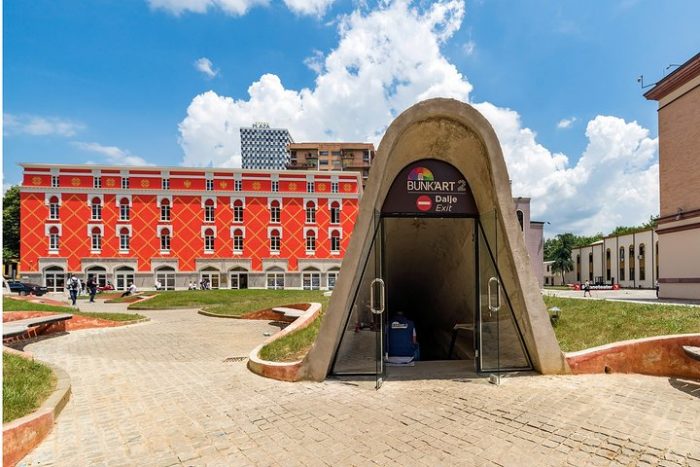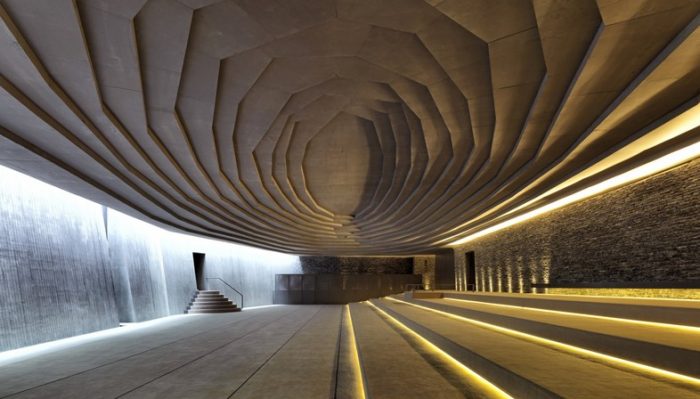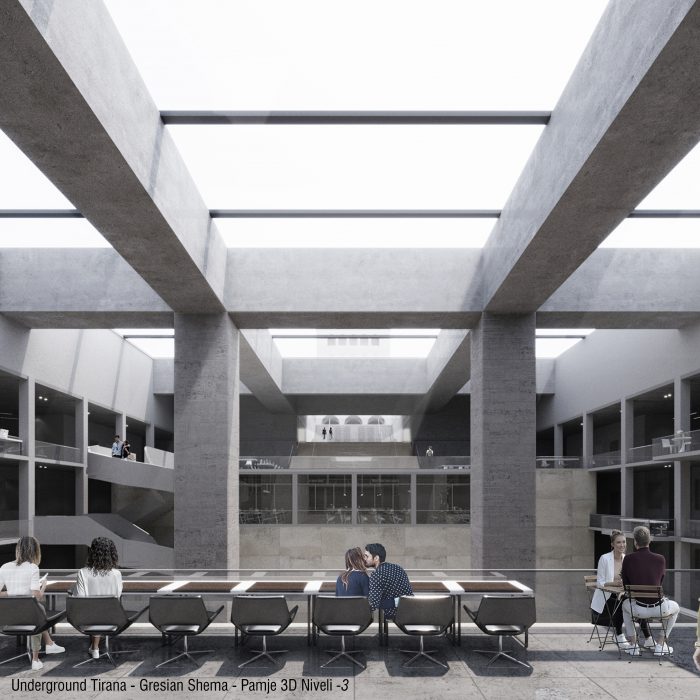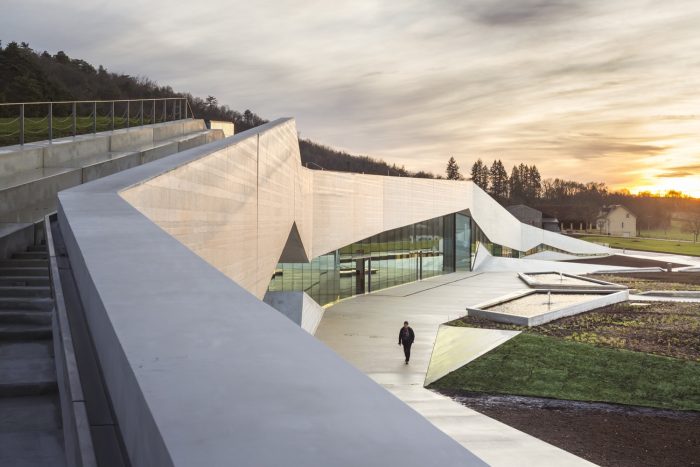
- Permbajtja
- prev
- next
- prev
- next
Underground architecture!
Ambition to build the most beautiful and fascinating building has always been challenging limits of the imagination and technology of the time!
As a symbol to display greatness and power, architecture has been the main mean of illustrating wealth and as such should have been visible, magnificient and rich!
But, there is an architecture which has evovled silently, discretely all underground!
Driven by the requirement for protection and need of privacy, underground architecture has existed since the genesis of humanity, let us remember caves as the most basic form! There are even whole cities developed underground like Derin Kuyu in Turkey in Cappadocia (Current Trend for Bloggers: P) which has housed around 20,000 people underground!
Some of the most significant issues are that underground space often lacks a building image, lacks boundaries and edges, and lacks legibility. These issues are significant in the fact that are important principles in creating quality public space, as public space must create a strong sense of enclosure to create a sense of threshold between inside and outside, must articulate distinct boundaries and edges to create a definitive shape and its space and access points must be easily legible.
One of the most profound issues facing underground space, and therefore its inhabitants, are the implications associated with lack of building image. Unlike conventional buildings, underground space has no perceivable mass and therefore has no building image. As explained by Camody and Sterling, the omission of this critical visual cue means that underground space is “less recognisable as objects or specific place".[1]
A typical expression of underground architecture are Bunkers, designed to protect its inhabitants from incoming bombs, flying shrapnel and other attacks was extensively used in World War I and World War II. A very common typology in Albania, even with structures up to 5 underground floors like Bunkart. (If you have not visited them we advise you to do so, so you can fully perceive the potential of underground architecture!)
Bunkart2
The perception of a subterranean object, on the other hand, is linked to human experience and play with both natural and artificial light, as well as the relationship with nature and above-ground structures!
Competition to conquer the sky continues today, and the race to build the world's tallest skyscrapers is still a hot topic. However, the approach to underground architecture has shifted, with the goal of maximizing the benefits that this architecture may provide, such as:
Minimal impact on the landscape, better use of spatial potential, earthquake resistance, safe environments in places with extreme climates, high thermal efficiency and consequently more energy savings, high acoustic insulation, etc.
Of course, there are drawbacks to underground architecture, the most significant of which is the lack of natural light, which has a direct impact on people's psychology, despite the fact that today's construction technology allows us to create well-lit underground projects , such as the ones we present today!
01. Antinori Winery - Archea Associati
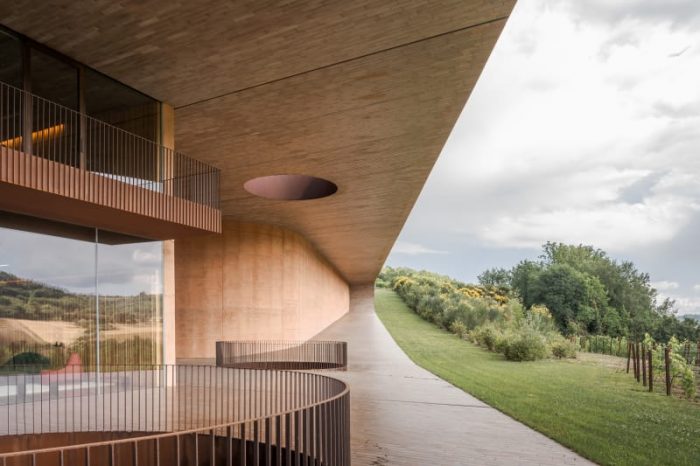 photography : Davide Adamo
photography : Davide Adamo
The 50,000-square-metre Antinori Winery, which was completed at the end of 2012, was designed as an invisible structure whose body blends into the folds of the Chianti hillside.
The physical and intellectual construction of the winery pivots on the profound and deep-rooted ties with the land, a relationship which is so intense and suffered (also in terms of economic investment) as to make the architectural image conceal itself and blend into it.
The purpose of the project has therefore been to merge the building and the rural landscape; the structure appears to be a part of the latter thanks to the roof, which has been turned into a plot of farmland cultivated with vines, interrupted, along the contour lines, by two horizontal cuts which let light into the interior and provide those inside the building with a view of the landscape through the imaginary construction of a diorama.
02. Tirpitz Museum - BIG Architects
photography : Laurian-Ghinitoiu
The new TIRPITZ is a sanctuary in the sand that acts as a gentle counterbalance to the dramatic war history of the site in Blåvand on the west coast of Denmark.
The 2,800 m2 ‘invisible museum’ transforms and expands a historic German WWII bunker into a groundbreaking cultural complex comprising four exhibitions within a single structure, seamlessly embedded into the landscape.
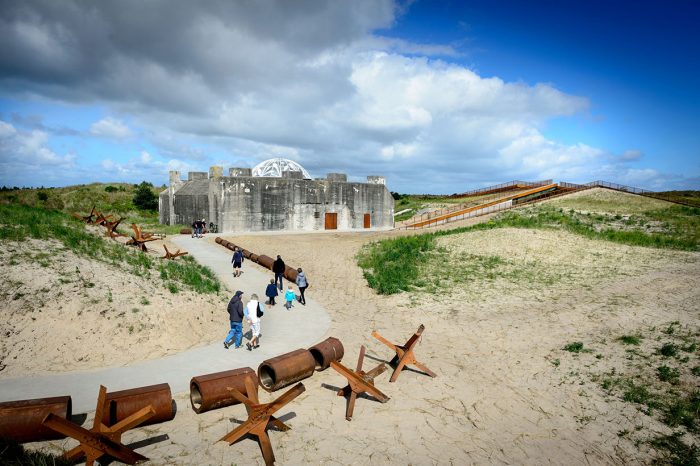 photography : Mike Bink
photography : Mike Bink
While set by the heavy hermetic object of the WWII bunker, the new TIRPITZ is a sharp contrast to the concrete monolith by camouflaging with the landscape and inviting lightness and openness into the new museum.
03. Sancaklar Mosque - Emre Arolat Architects
photography : Cemal Emden
Depending on the fact that a mosque does not have a predefined form and anywhere clean may be a prayer’s room, the project focused solely on the “essence” of a religious space, by distancing itself from discussions on form. Physical and emotional pleasure was at the forefront. The design aimed at representing purest forms of light and matter, just as a primary inner world, free from all cultural burdens. The disappearance of the building in the slope of the site, anchorage to the ground as if it has always been there, getting rid of all temporal and cultural engagements were aimed.
photography : Cemal Emden
The building blends in completely with the topography and in this peaceful way, delivers back the form of the ground. This submerging feature and the green roof all above provides a natural insulation against heat loss and gain. Landscape materials are mainly of rural plants that need no maintenance and that merges with the prairie of the surroundings.
04.Städel Museum extension - schneider + schumacher
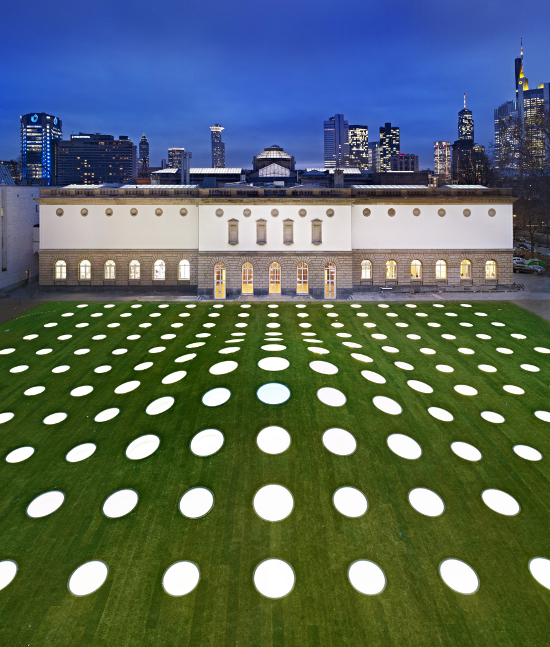 photography : Norbert Miguletz
photography : Norbert Miguletz
In Spring 2008, schneider+schumacher won the international competition to extend the Städel Museum in Frankfurt/Main. By placing the new building below the museum’s garden, they almost doubled the exhibition area from 4,000 m2 to 7,000 m2. The underground building is 76 m wide, 53 m long and a maximum of 8.20 m high at the centre. The new building was placed under the institution’s garden and includes 195 skylights, which control the flow of sunlight into the space.
The new building was placed under the institution’s garden and includes 195 skylights, which control the flow of sunlight into the space.
05. NCAVE house - Mold Architects
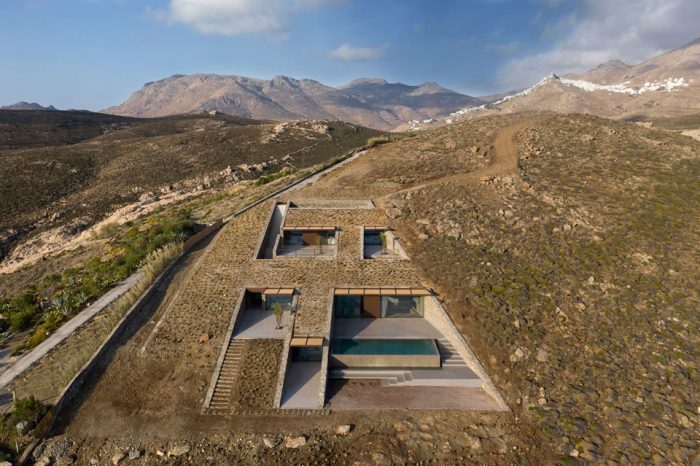 photography : Yiorgis Yerolymbos
photography : Yiorgis Yerolymbos
I doubt you haven't seen this example, which comes from the Greek island of Serifos.
The project has to take advantage of the breathtaking views while still being protected from the strong northerly winds. These circumstances influenced the choice to bury the house rather than expose it above ground.
Bedrooms are located at the narrow end of the building, further up the slope, while living areas and a guest apartment are located on the lower levels. This project not only conforms to the local environment excellently, but also provides stunning views of the landscape.
06.Underground visitor centre - nga Cerba
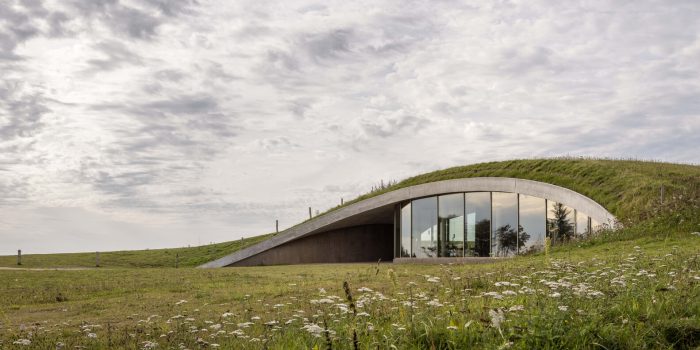 photography : Adam Moerk
photography : Adam Moerk
The rolling hills and meadows of Skamlingsbanken drove the design of the visitor center by CEBRA, by elevating the landscape along two circular cuts, the space swells into a subtle insertion in the landscape, and is finally expressed as a softly curving hill. the project functions as an exhibition space to illustrate skamlingsbanken’s history, including nature, democracy, and the power of speech.
07.Underground Tirana – Gresian Shema
Ky projekt diplome është e fokusuar në sheshin “Nënë. Tereza “ në Tiranë. Zgjidhja është bërë e tillë për të krijuar një shesh brenda (poshtë) sheshit ‘Nënë Tereza’. Kemi rrëshqitje të volumeve, hyrje-dalje të ballkoneve, dritare që hapen, atriumi dhe kolonat, të cilat krijojnë një ide të një “agora” për njerëzit që do të shijojnë objektet nga kjo hapësirë.
The diploma project is focused on ‘Mother Tereza’ Square, Tirana. The Idea was to create a square inside (below) the ‘Mother Teresa’ square. We have volume slides, several balconies, windows, a big atrium and columns, which create an ‘agora’ for people who will enjoy this space.
08. Low Line - RAAD Studio
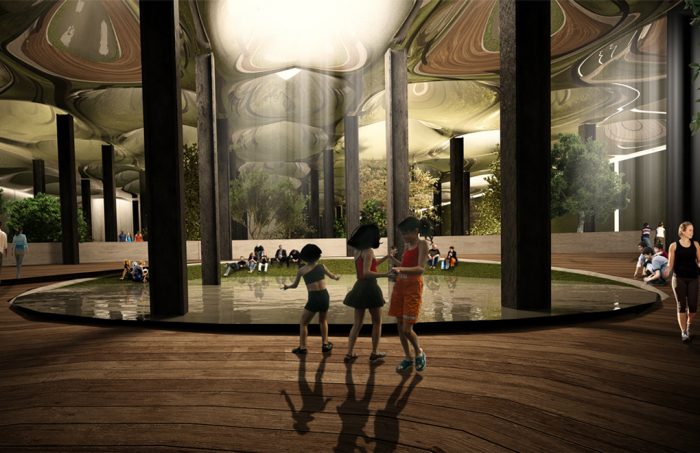 image by RAAD STUDIO
image by RAAD STUDIO
The Lowline is a plan to use innovative solar technology to illuminate an historic trolley terminal on the Lower East Side of New York City. The vision is a stunning underground park, providing a beautiful respite and a cultural attraction in one of the world’s most dense, exciting urban environments.
09. Underground house in Mosaraz- Aires Mateus
 photography: Joao Guimaraes
photography: Joao Guimaraes
An underground concrete house in Monsaraz, Portugal, by Aires Mateus is dug into a hillside and concealed by a green roof that cantilevers outwards. Sheltered by this curving concrete roof, the terrace of House in Monsaraz overlooks the nearby Alqueva lake.
Dug into a hillside and concealed by a green roof, the only visible elements of the building’s presence are the cantilevered roof jutting out towards the lake and the white-painted circular light wells, but even these are only visible from above.
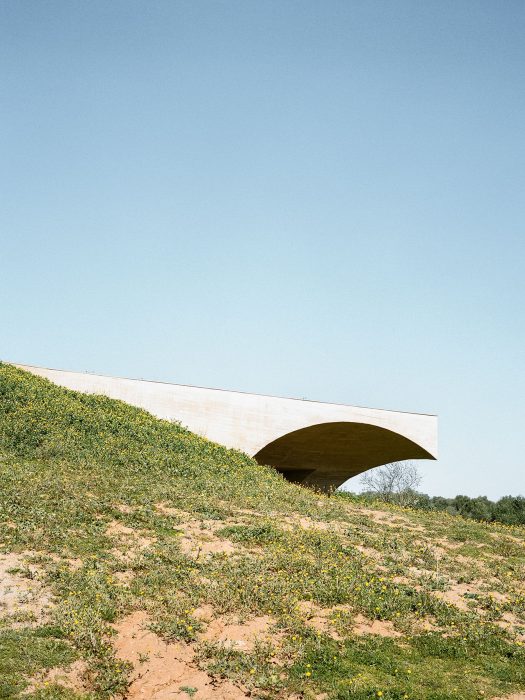 photography: Rui Cardoso
photography: Rui Cardoso
11. Lascaux IV Caves Museum - Snøhetta with SRA Architectes Snøhetta + Duncan Lewis Scape Architecture
Boegly + Grazia photographers,
The international centre for cave art, in Montignac, France offers visitors a look at the “Sistine Chapel of Prehistory” – the 20,000-year-old Lascaux cave paintings.
The museum itself, planted between a forested hillside and the fields of the Vézère Valley, is a jagged structure with an entrance that rises like a mountainscape, before descending below grade. Architects Snøhetta and Duncan Lewis Scape Architecture worked in association with scenographer Casson Mann to create a holistic museum that features replicas of the caves, created through advanced 3-D laser scanning and casting technologies.
[1] UNDERGROUND ARCHITECTURE Connections Between Ground-Level Public Space and Below-Ground Building - Aimee Wright Master Thesis

